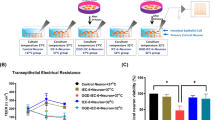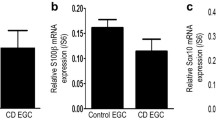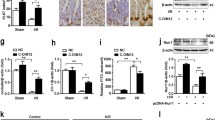Abstract
Acute intestinal ischemia reperfusion (IR) injury is often associated with intestinal epithelial barrier (IEB) dysfunction. Enteric glial cells (EGCs) play an essential role in maintaining the integrity of IEB functions. However, the precise mechanism of EGCs under IR stimulation remains unclear. Here, we report that EGCs are closely involved in the modulation of IEB functions in response to IR challenge. The intestinal IR treatment led to the significant upregulation of the EGC activation marker, glial fibrillary acidic protein, accompanied by the increasing abundance of glial-derived neurotrophic factor (GDNF) and inducible nitric oxidase (iNOS) proteins, which was also confirmed in in vitro hypoxia reoxygenation (HR) tests. Co-culturing with EGCs attenuated the tight junctional abnormalities, blocked the downregulation of ZO-1 and occludin protein expression, and relieved the decrease of permeability of intestinal epithelial cell (IEC) monolayers under HR treatment. Furthermore, exogenous GDNF administration displays the barrier-protective effects similar to EGCs against HR stimulation, while RNA interference-mediated knockdown of GDNF significantly inhibited the protective capability of EGCs. The expression of both GDNF and iNOS proteins of EGCs was significantly upregulated by co-culturing with IECs, which was further increased by HR treatment. Interestingly, through inhibiting iNOS activity, the barrier-protective effect of EGCs was influenced in normal condition but enhanced in HR condition. These results suggest that GDNF plays an important role in the barrier-protective mechanism of activated EGCs under IR stimulation, whereas EGCs (via iNOS release) are also involved in intestinal inflammation response, which may contribute to IEB damage induced by IR injury.







Similar content being viewed by others
References
Grotz MR, Deitch EA, Ding J, Xu D, Huang Q, Regel G (1999) Intestinal cytokine response after gut ischemia: role of gut barrier failure. Ann Surg 229(4):478–486
Lu YZ, Wu CC, Huang YC, Huang CY, Yang CY, Lee TC, Chen CF, Yu LC (2012) Neutrophil priming by hypoxic preconditioning protects against epithelial barrier damage and enteric bacterial translocation in intestinal ischemia/reperfusion. Lab Investig 92(5):783–796. doi:10.1038/labinvest.2012.11
Rock P, Yao Z (2002) Ischemia reperfusion injury, preconditioning and critical illness. Curr Opin Anaesthesiol 15(2):139–146
Neunlist M, Van Landeghem L, Mahe MM, Derkinderen P, des Varannes SB, Rolli-Derkinderen M (2013) The digestive neuronal–glial–epithelial unit: a new actor in gut health and disease. Nat Rev Gastroenterol Hepatol 10(2):90–100. doi:10.1038/nrgastro.2012.221
Ruhl A (2005) Glial cells in the gut. Neurogastroenterol Motil 17(6):777–790. doi:10.1111/j.1365-2982.2005.00687.x
Abdo H, Mahe MM, Derkinderen P, Bach-Ngohou K, Neunlist M, Lardeux B (2012) The omega-6 fatty acid derivative 15-deoxy-Delta(1)(2), (1)(4)-prostaglandin J2 is involved in neuroprotection by enteric glial cells against oxidative stress. J Physiol 590(Pt 11):2739–2750. doi:10.1113/jphysiol.2011.222935
Cabarrocas J, Savidge TC, Liblau RS (2003) Role of enteric glial cells in inflammatory bowel disease. Glia 41(1):81–93. doi:10.1002/glia.10169
Neunlist M, Van Landeghem L, Bourreille A, Savidge T (2008) Neuro-glial crosstalk in inflammatory bowel disease. J Intern Med 263(6):577–583. doi:10.1111/j.1365-2796.2008.01963.x
Savidge TC, Sofroniew MV, Neunlist M (2007) Starring roles for astroglia in barrier pathologies of gut and brain. Lab Investig 87(8):731–736. doi:10.1038/labinvest.3700600
Bassotti G, Villanacci V, Maurer CA, Fisogni S, Di Fabio F, Cadei M, Morelli A, Panagiotis T, Cathomas G, Salerni B (2006) The role of glial cells and apoptosis of enteric neurones in the neuropathology of intractable slow transit constipation. Gut 55(1):41–46. doi:10.1136/gut.2005.073197
Bush TG, Savidge TC, Freeman TC, Cox HJ, Campbell EA, Mucke L, Johnson MH, Sofroniew MV (1998) Fulminant jejuno-ileitis following ablation of enteric glia in adult transgenic mice. Cell 93(2):189–201
Steinkamp M, Geerling I, Seufferlein T, von Boyen G, Egger B, Grossmann J, Ludwig L, Adler G, Reinshagen M (2003) Glial-derived neurotrophic factor regulates apoptosis in colonic epithelial cells. Gastroenterology 124(7):1748–1757
Zhang DK, He FQ, Li TK, Pang XH, de Cui J, Xie Q, Huang XL, Gan HT (2010) Glial-derived neurotrophic factor regulates intestinal epithelial barrier function and inflammation and is therapeutic for murine colitis. J Pathol 222(2):213–222. doi:10.1002/path.2749
Koury J, Deitch EA, Homma H, Abungu B, Gangurde P, Condon MR, Lu Q, Xu DZ, Feinman R (2004) Persistent HIF-1alpha activation in gut ischemia/reperfusion injury: potential role of bacteria and lipopolysaccharide. Shock 22(3):270–277
von Boyen GB, Steinkamp M, Reinshagen M, Schafer KH, Adler G, Kirsch J (2006) Nerve growth factor secretion in cultured enteric glia cells is modulated by proinflammatory cytokines. J Neuroendocrinol 18(11):820–825. doi:10.1111/j.1365-2826.2006.01478.x
von Boyen GB, Steinkamp M, Geerling I, Reinshagen M, Schafer KH, Adler G, Kirsch J (2006) Proinflammatory cytokines induce neurotrophic factor expression in enteric glia: a key to the regulation of epithelial apoptosis in Crohn's disease. Inflamm Bowel Dis 12(5):346–354. doi:10.1097/01.mib.0000219350.72483.44
Cirillo C, Sarnelli G, Turco F, Mango A, Grosso M, Aprea G, Masone S, Cuomo R (2011) Proinflammatory stimuli activates human-derived enteroglial cells and induces autocrine nitric oxide production. Neurogastroenterol Motil 23(9):e372–e382. doi:10.1111/j.1365-2982.2011.01748.x
Xiao WD, Chen W, Sun LH, Wang WS, Zhou SW, Yang H (2011) The protective effect of enteric glial cells on intestinal epithelial barrier function is enhanced by inhibiting inducible nitric oxide synthase activity under lipopolysaccharide stimulation. Mol Cell Neurosci 46(2):527–534. doi:10.1016/j.mcn.2010.12.007
Miyashita S, Sagane Y, Inui K, Hayashi S, Miyata K, Suzuki T, Ohyama T, Watanabe T, Niwa K (2013) Botulinum toxin complex increases paracellular permeability in intestinal epithelial cells via activation of p38 mitogen-activated protein kinase. J Vet Med Sci 75(12):1637–1642
von Boyen GB, Steinkamp M, Reinshagen M, Schafer KH, Adler G, Kirsch J (2004) Proinflammatory cytokines increase glial fibrillary acidic protein expression in enteric glia. Gut 53(2):222–228
von Boyen GB, Schulte N, Pfluger C, Spaniol U, Hartmann C, Steinkamp M (2011) Distribution of enteric glia and GDNF during gut inflammation. BMC Gastroenterol 11:3. doi:10.1186/1471-230x-11-3
Steinkamp M, Gundel H, Schulte N, Spaniol U, Pflueger C, Zizer E, von Boyen GB (2012) GDNF protects enteric glia from apoptosis: evidence for an autocrine loop. BMC Gastroenterol 12:6. doi:10.1186/1471-230x-12-6
Lenaerts K, Ceulemans LJ, Hundscheid IH, Grootjans J, Dejong CH, Olde Damink SW (2013) New insights in intestinal ischemia–reperfusion injury: implications for intestinal transplantation. Curr Opin Organ Transplant 18(3):298–303. doi:10.1097/MOT.0b013e32835ef1eb
Mallick IH, Yang W, Winslet MC, Seifalian AM (2004) Ischemia–reperfusion injury of the intestine and protective strategies against injury. Dig Dis Sci 49(9):1359–1377
Thacker M, Rivera LR, Cho HJ, Furness JB (2011) The relationship between glial distortion and neuronal changes following intestinal ischemia and reperfusion. Neurogastroenterol Motil 23(11):e500–e509. doi:10.1111/j.1365-2982.2011.01696.x
Jiang S, Khan MI, Lu Y, Werstiuk ES, Rathbone MP (2005) Acceleration of blood–brain barrier formation after transplantation of enteric glia into spinal cords of rats. Exp Brain Res 162(1):56–62. doi:10.1007/s00221-004-2119-3
Abbott NJ, Ronnback L, Hansson E (2006) Astrocyte–endothelial interactions at the blood–brain barrier. Nat Rev Neurosci 7(1):41–53. doi:10.1038/nrn1824
Chen Y, Swanson RA (2003) Astrocytes and brain injury. J Cereb Blood Flow Metab 23(2):137–149
Farina C, Aloisi F, Meinl E (2007) Astrocytes are active players in cerebral innate immunity. Trends Immunol 28(3):138–145. doi:10.1016/j.it.2007.01.005
Messing A, Brenner M (2003) GFAP: functional implications gleaned from studies of genetically engineered mice. Glia 43(1):87–90. doi:10.1002/glia.10219
Nawashiro H, Brenner M, Fukui S, Shima K, Hallenbeck JM (2000) High susceptibility to cerebral ischemia in GFAP-null mice. J Cereb Blood Flow Metab 20(7):1040–1044. doi:10.1097/00004647-200007000-00003
Eng LF, Ghirnikar RS, Lee YL (2000) Glial fibrillary acidic protein: GFAP—thirty-one years (1969-2000). Neurochem Res 25(9–10):1439–1451
Hamby ME, Sofroniew MV (2010) Reactive astrocytes as therapeutic targets for CNS disorders. Neurotherapeutics 7(4):494–506. doi:10.1016/j.nurt.2010.07.003
Ruhl A, Nasser Y, Sharkey KA (2004) Enteric glia. Neurogastroenterol Motil 16(Suppl 1):44–49. doi:10.1111/j.1743-3150.2004.00474.x
Neunlist M, Aubert P, Bonnaud S, Van Landeghem L, Coron E, Wedel T, Naveilhan P, Ruhl A, Lardeux B, Savidge T, Paris F, Galmiche JP (2007) Enteric glia inhibit intestinal epithelial cell proliferation partly through a TGF-beta1-dependent pathway. Am J Physiol Gastrointest Liver Physiol 292(1):G231–G241. doi:10.1152/ajpgi.00276.2005
Bach-Ngohou K, Mahe MM, Aubert P, Abdo H, Boni S, Bourreille A, Denis MG, Lardeux B, Neunlist M, Masson D (2010) Enteric glia modulate epithelial cell proliferation and differentiation through 15-deoxy-12,14-prostaglandin J2. J Physiol 588(Pt 14):2533–2544. doi:10.1113/jphysiol.2010.188409
Van Landeghem L, Chevalier J, Mahe MM, Wedel T, Urvil P, Derkinderen P, Savidge T, Neunlist M (2011) Enteric glia promote intestinal mucosal healing via activation of focal adhesion kinase and release of proEGF. Am J Physiol Gastrointest Liver Physiol 300(6):G976–G987. doi:10.1152/ajpgi.00427.2010
Van Landeghem L, Mahe MM, Teusan R, Leger J, Guisle I, Houlgatte R, Neunlist M (2009) Regulation of intestinal epithelial cells transcriptome by enteric glial cells: impact on intestinal epithelial barrier functions. BMC Genomics 10:507. doi:10.1186/1471-2164-10-507
Nishikiori N, Osanai M, Chiba H, Kojima T, Mitamura Y, Ohguro H, Sawada N (2007) Glial cell-derived cytokines attenuate the breakdown of vascular integrity in diabetic retinopathy. Diabetes 56(5):1333–1340. doi:10.2337/db06-1431
Kamimura Y, Chiba H, Utsumi H, Gotoh T, Tobioka H, Sawada N (2002) Barrier function of microvessels and roles of glial cell line-derived neurotrophic factor in the rat testis. Med Electron Microsc 35(3):139–145. doi:10.1007/s007950200017
Igarashi Y, Utsumi H, Chiba H, Yamada-Sasamori Y, Tobioka H, Kamimura Y, Furuuchi K, Kokai Y, Nakagawa T, Mori M, Sawada N (1999) Glial cell line-derived neurotrophic factor induces barrier function of endothelial cells forming the blood–brain barrier. Biochem Biophys Res Commun 261(1):108–112. doi:10.1006/bbrc.1999.0992
Miyazaki H, Nagashima K, Okuma Y, Nomura Y (2001) Expression of glial cell line-derived neurotrophic factor induced by transient forebrain ischemia in rats. Brain Res 922(2):165–172
Jin G, Inoue M, Hayashi T, Deguchi K, Nagotani S, Zhang H, Wang X, Shoji M, Hasegawa M, Abe K (2008) Sendai virus-mediated gene transfer of GDNF reduces AIF translocation and ameliorates ischemic cerebral injury. Neurol Res 30(7):731–739. doi:10.1179/174313208x305418
Kannan KB, Colorado I, Reino D, Palange D, Lu Q, Qin X, Abungu B, Watkins A, Caputo FJ, Xu DZ, Semenza GL, Deitch EA, Feinman R (2011) Hypoxia-inducible factor plays a gut-injurious role in intestinal ischemia reperfusion injury. Am J Physiol Gastrointest Liver Physiol 300(5):G853–G861. doi:10.1152/ajpgi.00459.2010
Suzuki Y, Deitch EA, Mishima S, Lu Q, Xu D (2000) Inducible nitric oxide synthase gene knockout mice have increased resistance to gut injury and bacterial translocation after an intestinal ischemia–reperfusion injury. Crit Care Med 28(11):3692–3696
Olson N, Greul AK, Hristova M, Bove PF, Kasahara DI, van der Vliet A (2009) Nitric oxide and airway epithelial barrier function: regulation of tight junction proteins and epithelial permeability. Arch Biochem Biophys 484(2):205–213. doi:10.1016/j.abb.2008.11.027
Savidge TC, Newman P, Pothoulakis C, Ruhl A, Neunlist M, Bourreille A, Hurst R, Sofroniew MV (2007) Enteric glia regulate intestinal barrier function and inflammation via release of S-nitrosoglutathione. Gastroenterology 132(4):1344–1358. doi:10.1053/j.gastro.2007.01.051
Flamant M, Aubert P, Rolli-Derkinderen M, Bourreille A, Neunlist MR, Mahe MM, Meurette G, Marteyn B, Savidge T, Galmiche JP, Sansonetti PJ, Neunlist M (2011) Enteric glia protect against Shigella flexneri invasion in intestinal epithelial cells: a role for S-nitrosoglutathione. Gut 60(4):473–484. doi:10.1136/gut.2010.229237
Cheadle GA, Costantini TW, Lopez N, Bansal V, Eliceiri BP, Coimbra R (2013) Enteric glia cells attenuate cytomix-induced intestinal epithelial barrier breakdown. PLoS One 8(7):e69042. doi:10.1371/journal.pone.0069042
Kolios G, Valatas V, Ward SG (2004) Nitric oxide in inflammatory bowel disease: a universal messenger in an unsolved puzzle. Immunology 113(4):427–437. doi:10.1111/j.1365-2567.2004.01984.x
Guihot G, Guimbaud R, Bertrand V, Narcy-Lambare B, Couturier D, Duee PH, Chaussade S, Blachier F (2000) Inducible nitric oxide synthase activity in colon biopsies from inflammatory areas: correlation with inflammation intensity in patients with ulcerative colitis but not with Crohn's disease. Amino Acids 18(3):229–237
Acknowledgments
This work was supported by the National Nature Science Foundation of China (NSFC-81270451).
Conflict of interest
We declare that we have no conflict of interest.
Author information
Authors and Affiliations
Corresponding authors
Additional information
Weidong Xiao and Wensheng Wang contributed equally to this work.
Rights and permissions
About this article
Cite this article
Xiao, W., Wang, W., Chen, W. et al. GDNF is Involved in the Barrier-Inducing Effect of Enteric Glial Cells on Intestinal Epithelial Cells Under Acute Ischemia Reperfusion Stimulation. Mol Neurobiol 50, 274–289 (2014). https://doi.org/10.1007/s12035-014-8730-9
Received:
Accepted:
Published:
Issue Date:
DOI: https://doi.org/10.1007/s12035-014-8730-9




